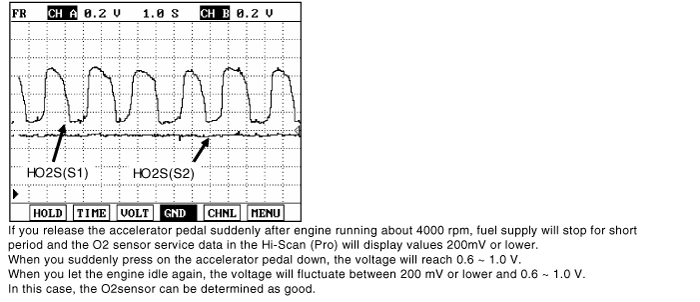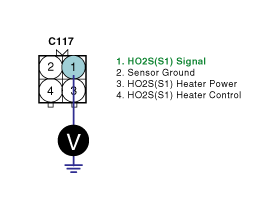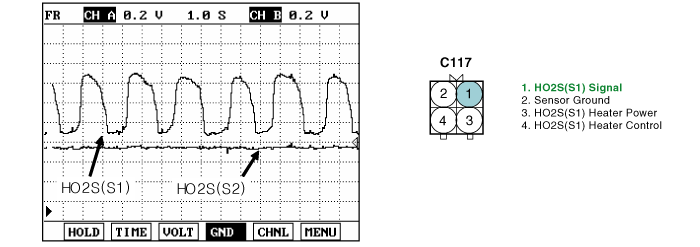Monitor "HO2S(B1S1)" parameter on scantool.


The heated oxygen sensors are mounted on the front side and the rear sied of Catalytic Converter (warm-up catalytic converter), which detects the oxygen concentration in the exhaust gas. The front HO2S signal is used to control air/fuel ratio (closed loop fuel control) and the rear HO2S signal is used to monitor front HO2S and catalyst for proper operation. The heated oxygen snesor (HO2S) produces a voltage that varies between 0V and 1V. When the air/fuel ratio is lean, the oxygen concentration in the exhaust gas increases and the front HO2S outputs a low voltage (approximately 0 ~ 0.1 V).
When the air/fuel ratio is rich, the oxygen concentration in the exhaust gas decreases and the front HO2S output a high voltage (approximately 0.8 ~ 1 V). The ECM constantly monitors the HO2S and increases or decreases the fuel injection duration by using the HO2S signal, which is called closed-loop fuel control operation.
If ECM detects that the output signal satisfies the threshold values under enable conditions, ECM sets DTC P0130.
( This DTC might be caused by the malfunction of Heater circuit, so, check the heater circuit first. )
Item | Detecting Condition | Possible Cause | |
DTC Strategy | ● Rationality check | ● Poor connection ● Open or short power/ground in signal circuit ● B1S1 ● ECM | |
General Enable Conditions | ● Dew point end detected ● Required lambda = 1 ● Battery voltage 〉 10.7V ● Exhaust gas temperature (model) 〈 800℃ ● Heater control enabled | ||
Case1 | Enable Conditions | ● B1S2 sensor voltage 〉 0.5V | |
Threshold Value | ● B1S1 sensor voltage : 0.06 ~ 0.4V | ||
Diagnostic Time | ● 25 sec | ||
Case2 | Enable Conditions | ● B1S2 sensor voltage 〈 0.1V | |
Threshold Value | ● B1S1 sensor voltage : 0.6 ~ 1.5V | ||
Diagnostic Time | ● 25 sec | ||
Case3 | Enable Conditions | ● Time after dew point end detected 〉 10s | |
Threshold Value | ● Counter of l △usvk 〉 2V during 0.04 sec after heater on→off l 〉 5 times | ||
MIL ON Condition | ● 3 driving cycle | ||
※△usvk : Sum of the signal voltage change value (B1S1)
※ B1S1 : upstream oxygen sensor / B1S2 : downstream oxygen sensor

A/F Ratio | Output Voltage (V) |
Rich | 0.6 ~ 1.0V |
Lean | 0 ~ 0.4V |

Connect scantool to DLC (Data Link Cable).
Warm up the engine to normal operating temperature.
Monitor "HO2S(B1S1)" parameter on scantool.

Is the "HO2S(B1S1)" parameter operating correctly?

▶ Fault is intermittent caused by poor contact in the sensor’s and/or ECM’s connector or was repaired and ECM memory was not cleared. Thoroughly check connectors for looseness, poorconnection, ending, corrosion, contamination, deterioration, or damage. Repair or replace asnecessary and go to "Verification of Vehicle Repair" procedure.

▶ Go to "Terminal and Connector Inspection" procedure.
This DTC might be caused by the malfunction of Heater circuit, so, check the heater circuit first.
Many malfunctions in the electrical system are caused by poor harness and terminals. Faults can also be caused by interference from other electrical systems, and mechanical or chemical damage.
Thoroughly check connectors for looseness, poor connection, bending, corrosion, contamination, deterioration, or damage.
Has a problem been found?

▶ Repair as necessary and go to "Verification of vehicle Repair" procedure.

▶ Go to " Signal Circuit Inspection " procedure.
IG "OFF".
Disconnect HO2S(B1/S1) connector.
IG "ON" & ENG "OFF".
Measure voltage between terminal 1 of HO2S(B1/S1) and chassis ground.
Specification : Approx. 0.45V

Is the measured voltage within specification?

▶ Go to "Groud Circuit Inspection" procedure.

▶ Repair or replace as necessary and then, go to "Verification of Vehicle Repair"procedure.
IG "OFF".
Disconnect HO2S(B1/S1) connector.
Measure resistance between terminal 2 of HO2S(B1/S1) and chassis ground.
Specification : Approx. below 1Ω

Is the measured resistance within specification?

▶ Go to "Component Inspection" procedure.

▶ Repair or replace as necessary and then, go to "Verification of Vehicle Repair" procedure.
Visual Inspection.
IG "OFF"
Disconnect HO2S(B1/S1) connector.
Check that HO2S(B1S1) is contaminated or damaged by foreign materials.
Has a problem been found?

▶ Go to "Check HO2S(B1/S1) performance" as follows.

▶ Substitute with a known - good HO2S(B1/S1) and check for proper operation.
▶ If the problem is corrected, replace HO2S(B1/S1) and go to "Verification of Vehicle Repair" procedure.
Check HO2S(B1/S1) performance.
IG "OFF".
Connect probe to terminal 1 of HO2S(B1/S1) connector and select oscilloscope function with scantool.
Warm up the engine to normal operating temperature.
Measure signal waveform of HO2S(B1/S1) with scantool.

Is the measured signal waveform within specification?

▶ Go to "Check ECM" as follows.

▶ Substitute with a known - good HO2S(B1/S1) and check for proper operation.
▶ If the problem is corrected, replace HO2S(B1/S1) and go to "Verification of Vehicle Repair" procedure.
Check ECM.
IG "OFF" and disconnect B1S1 connector.
Connect scantool and Key "ON".
Select simulation function on scantool.
Simulate voltage at terminal 1 of HO2S(B1/S1) signal connector.

Does the signal value of HO2S(B1/S1) change according to simulation voltage?

▶ Thoroughly check connectors for looseness, poor connection, bending, corrosion,contamination, deterioration, or damage. Repair or replace as necessary and go to "Verificationof Vehicle Repair" procedure.

▶ Substitute with a known - good ECM and check for proper operation.
▶ If the problem is corrected, replace ECM and go to "Verification of Vehicle Repair" procedure.
After a repair, it is essential to verify that the fault has been corrected.
Connect scan tool and select "Diagnostic Trouble Codes(DTCs)" mode.
Clear the DTCs and Operate the vehicle within DTC Enable conditions in General information.
Are any DTCs present ?

▶ Go to the applicable troubleshooting procedure.

▶ System is performing to specification at this time.